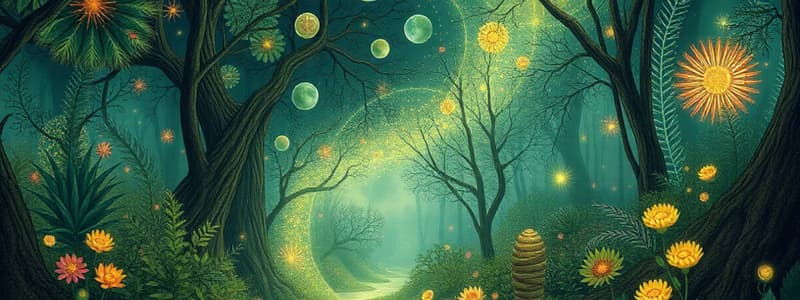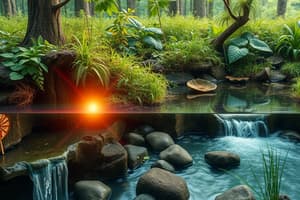Podcast
Questions and Answers
What is the primary source of energy in most ecosystems?
What is the primary source of energy in most ecosystems?
- Abiotic factors
- Heterotrophs
- Autotrophs (correct)
- Decomposers
Which level of ecology includes both biotic and abiotic factors?
Which level of ecology includes both biotic and abiotic factors?
- Community
- Organism
- Ecosystem (correct)
- Population
Which of the following best describes a population in ecology?
Which of the following best describes a population in ecology?
- All the abiotic factors influencing an area
- All the individuals of a species within a certain area (correct)
- The interactions between different species in an area
- All the living organisms in a specific environment
What is the main role of decomposers in an ecosystem?
What is the main role of decomposers in an ecosystem?
What percentage of energy typically transfers from one trophic level to the next in a food chain?
What percentage of energy typically transfers from one trophic level to the next in a food chain?
Which characteristic defines autotrophs?
Which characteristic defines autotrophs?
Which of the following is a feature of heterotrophs?
Which of the following is a feature of heterotrophs?
In a food chain, what do the arrows represent?
In a food chain, what do the arrows represent?
Which definition best fits biome?
Which definition best fits biome?
Which of the following is NOT a characteristic of an ecosystem?
Which of the following is NOT a characteristic of an ecosystem?
Flashcards
Biotic
Biotic
All the living things in an ecosystem.
Abiotic
Abiotic
All the non-living things in an ecosystem.
Ecology
Ecology
The study of living things and their interactions with each other and their environment.
Organism
Organism
Signup and view all the flashcards
Population
Population
Signup and view all the flashcards
Community
Community
Signup and view all the flashcards
Ecosystem
Ecosystem
Signup and view all the flashcards
Autotroph
Autotroph
Signup and view all the flashcards
Heterotroph
Heterotroph
Signup and view all the flashcards
Food Chain
Food Chain
Signup and view all the flashcards
Study Notes
Unit 1 - Energy and Matter Flow
- Energy in most ecosystems originates from the sun.
- Abiotic factors are non-living components like water, air, and soil..
- Biotic factors are living organisms like plants and animals.
- An organism is a single living thing.
- A population is a group of organisms of the same species in an area.
- A community is a collection of populations living together..
- An ecosystem includes both biotic and abiotic factors.
- A biome is a large geographic area with similar climate and organisms.
- The biosphere encompasses all life on Earth.
- Examples of autotrophs are plants, as they produce their own food through photosynthesis.
- Heterotrophs, such as animals, need to consume other organisms for sustenance.
- Food chains exhibit energy flow through an ecosystem.
- Food chains originate with producers (autotrophs).
- Arrows illustrate energy transfer in a food chain.
- Only approximately 10% of energy is transferred to the next trophic level.
Levels of Ecology
- Organism: A single individual.
- Population: Organisms of the same species in a given area.
- Community: All populations in a given area.
- Ecosystem: The community and all abiotic factors.
- Biome: Large geographic region with similar climate and organisms..
- Biosphere: The entire planet's living organisms and their environment.
Differences between Autotrophs and Heterotrophs
- Autotrophs produce their own food (e.g., plants).
- Heterotrophs consume other organisms for energy (e.g., animals).
Food Chains and Food Webs
- Food chains show the direct linear flow of energy in an ecosystem.
- Food webs demonstrate the complex interconnected energy relationships between organisms.
Energy Transfer in Ecosystems
- Only about 10% of energy is transferred from one trophic level to the next.
Water Cycle
- Accumulation: Water collecting in a location.
- Condensation: Water vapor cooling and forming clouds.
- Evaporation: Liquid water changing to gas.
- Precipitation: Water falling from the sky.
Essential Elements in Ecosystems
- Carbon, nitrogen, and oxygen are key elements cycling through ecosystems.
Photosynthesis and Cellular Respiration
- Photosynthesis converts light energy to chemical energy in the form of sugar.
- Cellular respiration releases chemical energy stored in food (sugar) to produce usable energy.
Unit 2 - Biomes and Adaptations
- Biome: A large geographic area with specific climate and organisms adapted to it..
- Climate: A region's long-term weather pattern. Examples include tundra, taiga, and tropical forests.
Unit 3: Biodiversity
- Symbiosis: A relationship where two species live in close proximity..
- Mutualism: (+/+) Both organisms benefit.
- Commensalism: (+/0) One organism benefits, and the other is not affected..
- Parasitism: (+/-) One organism benefits, and the other is harmed.
Invasive Species
- Invasive species: Non-native organisms that cause negative effects on an ecosystem's biodiversity.
- Examples of effects include harm to food webs and biodiversity loss.
Unit 4 - Populations
- Population: A group of a single species.
- Population Density: The number of individuals per unit area.
- Exponential Growth: A growth pattern with a continuous increase.
- Logistic Growth: A growth pattern that levels off as resources are reduced.
- Carrying Capacity: The maximum number of individuals a given environment can support.
- Limiting Factors: Environmental restrictions influencing population growth..
- Density Dependent Factors: Factors affected by population density, like disease and competition.
- Density Independent Factors: Factors unaffected by population density, like natural disasters..
- Population Distribution: How populations are distributed across an area.
Studying That Suits You
Use AI to generate personalized quizzes and flashcards to suit your learning preferences.
Related Documents
Description
Explore the intricate concepts of energy flow and matter in ecosystems. This quiz covers essential terms like abiotic and biotic factors, food chains, and the classification of organisms. Test your understanding of how various components interact within different ecological settings.




